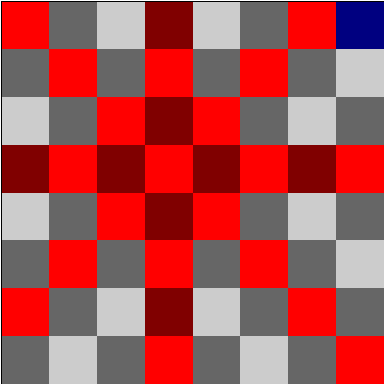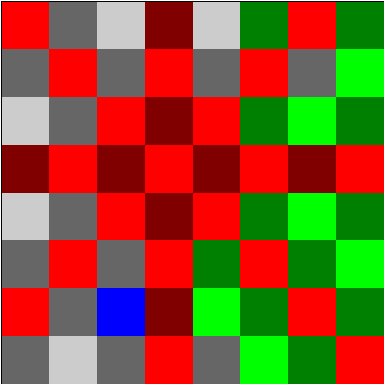
I’ve stumbled upon a websited called Ain’t it funny how the knight moves?, which poses a simple problem: Visit all squares of the chessboard, except those attacked (or occupied) by a queen on d5, using a knight starting from h8.

You cannot land on any of the red squares; you can visit any other square multiple times.
The language most suitable for this is obviously Prolog. First let’s define valid positions: both coordinates are between 1 and 8, and excluding the red squares:
valid(X-Y) :-
between(1, 8, X), between(1, 8, Y),
X =\= 4, Y =\= 5,
X + Y =\= 9, Y - X =\= 1.Now we can define a valid move as
knight(1, 2). knight(1, -2). knight(-1, 2). knight(-1, -2).
knight(2, 1). knight(2, -1). knight(-2, 1). knight(-2, -1).
move(X-Y, X1-Y1) :-
knight(DX, DY),
X1 is X + DX, Y1 is Y + DY,
valid(X1-Y1).The core of the solver will be the jump/4 rule. It keeps
track of the current position, the already visited squares, and the
current path:
jump(_, Visited, Path, Path) :- length(Visited, 36), !.
jump(Pos, Visited, Path, Solution) :-
move(Pos, Pos1),
add_new(Pos1, Visited, Path, Visited1),
jump(Pos1, Visited1, [Pos1|Path], Solution).The first rule says that when we have already visited all 36 goal
squares, the solution (last parameter) will be the current path. The
second rule says that we try to move to a new position
(Pos1), add it to the list of Visited places
if not yet visited, and continue jumping, adding the new position to the
current path. Note that the path is built in reverse order.
The add_new/4 rule also ensures that we do not visit a
square again when nothing new was seen since the last visit:
add_new(Pos, Visited, Path, Visited) :-
member(Pos, Visited), !,
Visited = [Last|_],
tail(Pos, Path, Tail),
\+ member(Last, Tail).
add_new(Pos, Visited, _, [Pos|Visited]).The check is implemented in the first rule. When the position has
already been visited, we check the part of the (reversed) path that
starts at our last visit - this is computed by tail/3. If
this contains the last visited square, it means that we haven’t visited
anything new, so we are not allowed to make this move.
The tail/3 rule is quite trivial:
tail(X, [X|T], [X|T]) :- !.
tail(X, [Y|Ys], T) :- X \= Y, tail(X, Ys, T).Finally, we just call jump/4 with suitable arguments,
and reverse the solution:
solve(X) :- jump(8-8, [8-8], [8-8], Path), reverse(Path, X).The solution is found in an instant, but it is quite long:
?- solve(X), length(X, N).
X = [8-8, 7-6, 8-4, 7-6, ...],
N = 257 That’s 256 moves after the initial position! Looks a bit too many, but it’s hard to tell by just these numbers. Let’s create some graphical output!
We’ll use PostScript for the output, which can be then converted to PDF. The squares will be colored according to the following rules:

The main rule will be show/1 that takes a path and
prints one page for each state of the board. Using 50x50 point squares,
the whole board fits nicely in a 500x500 page, so we first write the
header:
show(Path) :-
write('%!PS-Adobe-2.0'), nl,
write('%%BoundingBox: 0 0 500 500'), nl,
show(Path, []).The last row calls show/2, where the second parameter is
the list of already visited squares.
In PostScript, we can write the outline of a square by x
y width height rectstroke, and
fill a square by x y width height
rectfill. The color can be set by red
green blue setrgbcolor, where the
parameters take values between 0 and 1.
On each page, we first draw the outline rectangle, then fill each
square; the showpage command marks the end of the page. To
loop on all squares we can use the builtin forall rule:
show([], _).
show([Current|Path], Seen) :-
write('50 50 400 400 rectstroke'), nl,
forall((between(1, 8, X), between(1, 8, Y)),
(
color(Current, Seen, X-Y, c(R,G,B)),
write(R), write(' '), write(G), write(' '), write(B),
write(' setrgbcolor '),
X1 is X * 50, Y1 is Y * 50,
write(X1), write(' '), write(Y1),
write(' 50 50 rectfill'), nl
)),
write(showpage), nl,
show(Path, [Current|Seen]).The color/4 rule determines the color based on the
square type:
color(Current, Seen, X-Y, Color) :-
base_color(Current, Seen, X-Y, c(R,G,B)),
( (X + Y) mod 2 =:= 0 ->
R1 is R / 2, G1 is G / 2, B1 is B / 2,
Color = c(R1,G1,B1)
; Color = c(R,G,B)
).
base_color(_, _, Pos, c(1,0,0)) :- \+ valid(Pos).
base_color(Current, _, Current, c(0,0,1)).
base_color(_, Seen, Pos, c(0,1,0)) :- member(Pos, Seen).
base_color(_, _, _, c(0.8,0.8,0.8)).Generating the commands, I put them in a file called
knight.ps, then called GhostScript to convert it to
PDF:
$ gs -o knight.pdf -sDEVICE=pdfwrite -g5000x5000 knight.psHere is the output. As I suspected,
there is a lot of unnecessary jumping, because the solver always tries
the moves in a predefined sequence (according to the
knight/2 rule).
A better approach may be to use a greedy algorithm: always find the closest new (not visited) square! In order to do this, we first try to find a square 1 jump away, then 2 and so on, until one is found:
find_closest(Pos, Visited, Solution) :-
between(1, 36, N),
find_in(N, Pos, Visited, [], Solution).The find_in/5 rule tries to find a new square in
N jumps (the first parameter).
find_in(_, Pos, Visited, Path, Path) :-
\+ member(Pos, Visited), !.
find_in(0, _, _, _, _) :- !, fail.
find_in(N, Pos, Visited, Path, Solution) :-
N > 0, N1 is N - 1,
move(Pos, Pos1),
find_in(N1, Pos1, Visited, [Pos1|Path], Solution).Now we only need to update the jump/4 rule to use
find_closest/3:
jump(_, Visited, Path, Path) :- length(Visited, 36), !.
jump(Pos, Visited, Path, Solution) :-
find_closest(Pos, Visited, [Pos1|Path1]),
append([Pos1|Path1], Path, Path2),
jump(Pos1, [Pos1|Visited], Path2, Solution).The second rule says that we find the path to the closest new square
- the new square is Pos1; the path leading to it (but not
including it) is Path1. We append the old path to the new
one, and continue to jump recursively.
Now the solution consists of only 58 moves! That’s good enough for me, although it may not be optimal.
valid(X-Y) :-
between(1, 8, X), between(1, 8, Y),
X =\= 4, Y =\= 5,
X + Y =\= 9, Y - X =\= 1.
knight(1, 2). knight(1, -2). knight(-1, 2). knight(-1, -2).
knight(2, 1). knight(2, -1). knight(-2, 1). knight(-2, -1).
move(X-Y, X1-Y1) :-
knight(DX, DY),
X1 is X + DX, Y1 is Y + DY,
valid(X1-Y1).
jump(_, Visited, Path, Path) :- length(Visited, 36), !.
jump(Pos, Visited, Path, Solution) :-
find_closest(Pos, Visited, [Pos1|Path1]),
append([Pos1|Path1], Path, Path2),
jump(Pos1, [Pos1|Visited], Path2, Solution).
find_closest(Pos, Visited, Solution) :-
between(1, 36, N),
find_in(N, Pos, Visited, [], Solution).
find_in(_, Pos, Visited, Path, Path) :-
\+ member(Pos, Visited), !.
find_in(0, _, _, _, _) :- !, fail.
find_in(N, Pos, Visited, Path, Solution) :-
N > 0, N1 is N - 1,
move(Pos, Pos1),
find_in(N1, Pos1, Visited, [Pos1|Path], Solution).
solve(X) :- jump(8-8, [8-8], [8-8], Path), reverse(Path, X).
% PostScript output
show(Path) :-
write('%!PS-Adobe-2.0'), nl,
write('%%BoundingBox: 0 0 500 500'), nl,
show(Path, []).
show([], _).
show([Current|Path], Seen) :-
write('50 50 400 400 rectstroke'), nl,
forall((between(1, 8, X), between(1, 8, Y)),
(
color(Current, Seen, X-Y, c(R,G,B)),
write(R), write(' '), write(G), write(' '), write(B),
write(' setrgbcolor '),
X1 is X * 50, Y1 is Y * 50,
write(X1), write(' '), write(Y1),
write(' 50 50 rectfill'), nl
)),
write(showpage), nl,
show(Path, [Current|Seen]).
color(Current, Seen, X-Y, Color) :-
base_color(Current, Seen, X-Y, c(R,G,B)),
( (X + Y) mod 2 =:= 0 ->
R1 is R / 2, G1 is G / 2, B1 is B / 2,
Color = c(R1,G1,B1)
; Color = c(R,G,B)
).
base_color(_, _, Pos, c(1,0,0)) :- \+ valid(Pos).
base_color(Current, _, Current, c(0,0,1)).
base_color(_, Seen, Pos, c(0,1,0)) :- member(Pos, Seen).
base_color(_, _, _, c(0.8,0.8,0.8)).